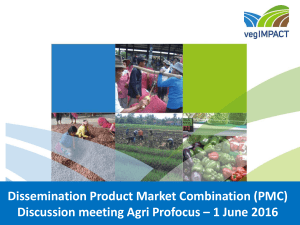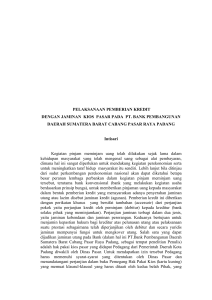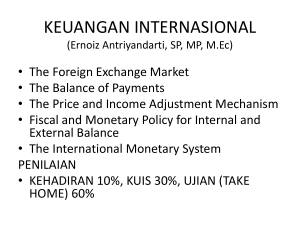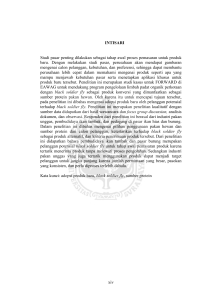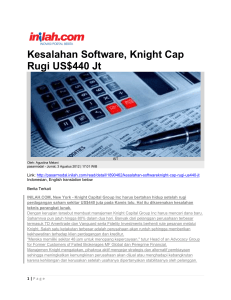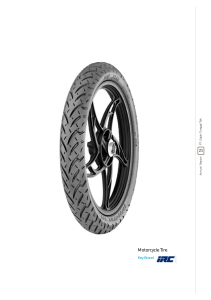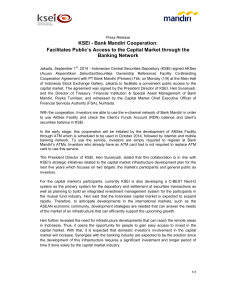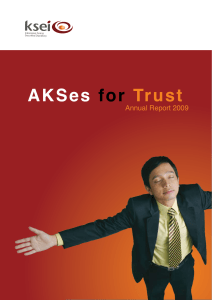Proceeding ICGRC 2013 - Proceeding International Conference on
advertisement
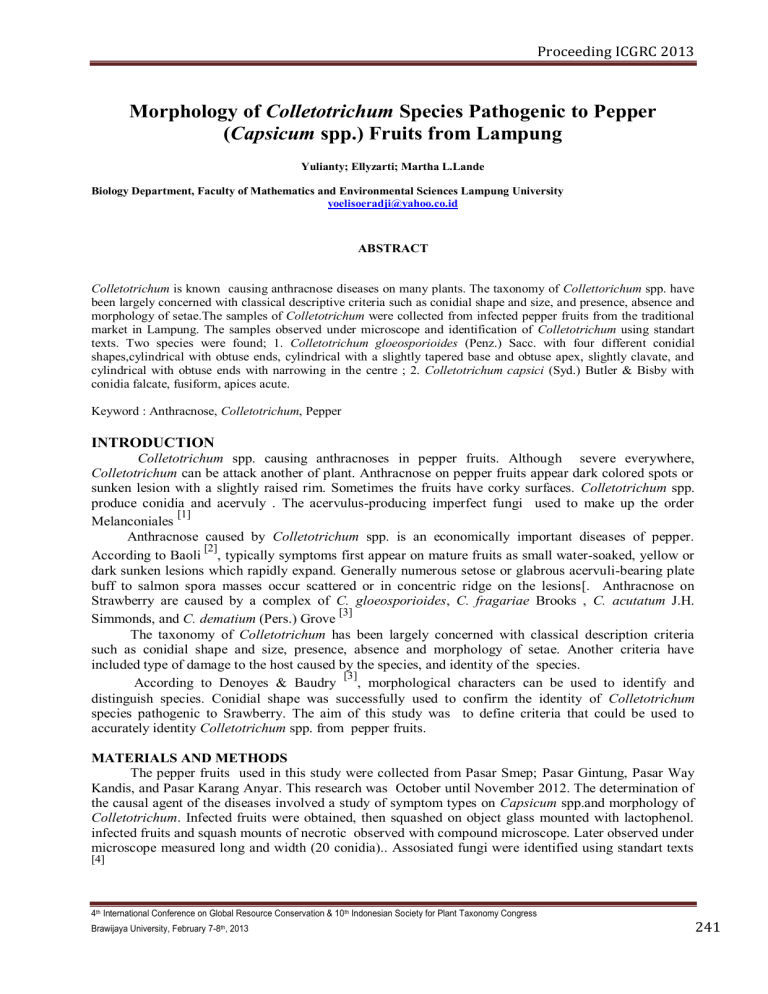
Proceeding ICGRC 2013 Morphology of Colletotrichum Species Pathogenic to Pepper (Capsicum spp.) Fruits from Lampung Yulianty; Ellyzarti; Martha L.Lande Biology Department, Faculty of Mathematics and Environmental Sciences Lampung University [email protected] ABSTRACT Colletotrichum is known causing anthracnose diseases on many plants. The taxonomy of Collettorichum spp. have been largely concerned with classical descriptive criteria such as conidial shape and size, and presence, absence and morphology of setae.The samples of Colletotrichum were collected from infected pepper fruits from the traditional market in Lampung. The samples observed under microscope and identification of Colletotrichum using standart texts. Two species were found; 1. Colletotrichum gloeosporioides (Penz.) Sacc. with four different conidial shapes,cylindrical with obtuse ends, cylindrical with a slightly tapered base and obtuse apex, slightly clavate, and cylindrical with obtuse ends with narrowing in the centre ; 2. Colletotrichum capsici (Syd.) Butler & Bisby with conidia falcate, fusiform, apices acute. Keyword : Anthracnose, Colletotrichum, Pepper INTRODUCTION Colletotrichum spp. causing anthracnoses in pepper fruits. Although severe everywhere, Colletotrichum can be attack another of plant. Anthracnose on pepper fruits appear dark colored spots or sunken lesion with a slightly raised rim. Sometimes the fruits have corky surfaces. Colletotrichum spp. produce conidia and acervuly . The acervulus-producing imperfect fungi used to make up the order [1] Melanconiales Anthracnose caused by Colletotrichum spp. is an economically important diseases of pepper. [2] According to Baoli , typically symptoms first appear on mature fruits as small water-soaked, yellow or dark sunken lesions which rapidly expand. Generally numerous setose or glabrous acervuli-bearing plate buff to salmon spora masses occur scattered or in concentric ridge on the lesions[. Anthracnose on Strawberry are caused by a complex of C. gloeosporioides, C. fragariae Brooks , C. acutatum J.H. [3] Simmonds, and C. dematium (Pers.) Grove The taxonomy of Colletotrichum has been largely concerned with classical description criteria such as conidial shape and size, presence, absence and morphology of setae. Another criteria have included type of damage to the host caused by the species, and identity of the species. [3] According to Denoyes & Baudry , morphological characters can be used to identify and distinguish species. Conidial shape was successfully used to confirm the identity of Colletotrichum species pathogenic to Srawberry. The aim of this study was to define criteria that could be used to accurately identity Colletotrichum spp. from pepper fruits. MATERIALS AND METHODS The pepper fruits used in this study were collected from Pasar Smep; Pasar Gintung, Pasar Way Kandis, and Pasar Karang Anyar. This research was October until November 2012. The determination of the causal agent of the diseases involved a study of symptom types on Capsicum spp.and morphology of Colletotrichum. Infected fruits were obtained, then squashed on object glass mounted with lactophenol. infected fruits and squash mounts of necrotic observed with compound microscope. Later observed under microscope measured long and width (20 conidia).. Assosiated fungi were identified using standart texts [4] 4th International Conference on Global Resource Conservation & 10th Indonesian Society for Plant Taxonomy Congress Brawijaya University, February 7-8th, 2013 241 Proceeding ICGRC 2013 RESULT Host and dimensions of conidia could be seen on Table I in below. The color of coloni of Colletotrichum gloeosporioides on pepper fruits from dark greyish to grey. C.gloeosporioides were found all market in Lampung and all on Capsicum annuum ( red; green pepper) and Capsicum frutescens (Table 1). But C. capsici were found on Pasar Gintung , Pasar Smep, and Pasar Karang Anyar.. Host of C. capsici only Capsicum annuum (red pepper) with black color of colony. Range and average of conidium measurement of each sample are presented in Table 1. Average of C.gloeosporioides were 11 – 21 µm long and 3 – 4 µm wide. Setae of C.gloeosporioides not abundant. There were different conidial shapes distinguished; cylindrical with a slightly tapered base and obtuse apex; cylindrical with obtuse apex slightly clavate, and cylindrical with obtuse ends with narrowing in the centre. (Fig 1 E; F). This measurement were similar in size to conidia recorded by Gunnel and Gubler [4] [8] and Sutton . Setae of C.gloeosporioides dark brown toward the base and tapered a long entire length to pointed apex. Setae not abundant, and this setae didn’t produced conidia. Gunnell and Gubler also found that setae not produce by C. gloeosporioides . According to Lenne et.al., setae of C. gloeosporioides are their ability act as conidiophores or setae produced conidia. Conidia of all C. capsici were consistenly falcate, fusiform, apices acute. Conidial dimensions of C. capsici were 15 – 29 µm long and 2 – 4 µm. This result were in general agreement with dimension [6] reported by Robert and Snow , in their original descriptions, 14,3 – 35,1 µm long and 2,6 – 5,2 µm. Setae abundant. Setae on the apical cell of C capsici producing conidia. (Fig 1 K) Table I. Host, Origin, and Dimensions (µm) of Conidia of Colletotrichum spp. Host Capsicum frutescens Capsicum frutescens Capsicum annuum Capsicum annuum Capsicum annuum Capsicum annuum Capsicum annuum Capsicum annuum Origin Conidia Pasar Gintung 11- (13,6) - 20 x 3- (3,3) - 4 Pasar Gintung 11- (12,9) - 15 x 3- (3,3) - 4 Pasar Gintung 12- (13,7) - 21 x 3- (3,3) - 4 Pasar Smep 11- (13,1) - 16 x 3- (3,3) - 4 Pasar Kandis 11- (14,3) - 18 x 3- (3,6) - 4 Pasar Gintung 15- (19,6) - 24 x 3- (3,5) - 4 Pasar Smep 22- (25,5) - 29 x 3- (3,8) - 4 Pasar Karang Anyat 19- (22,1) - 26 x 2- (2,7) - 4 Species C. gloeosporioides C. gloeosporioides C. gloeosporioides C. gloeosporioides C. gloeosporioides C. capsici C. capsici C. capsici DISCUSSION Conidial shapes and the presence or absence of setae bearing conidia are important morphological characteristic identify C. gloeosporioides and C. capsici. In this study, we identified the Colletotrichum spp. causing pepper anthracnose and aimed to determine whether the same or different species occur in pepper fruits in traditional market. Conidial shape and setae bearing conidia are fairly stable character. [8] Sutton reported that conidia of C. gloeosporioides are straight, obtuse at the apex. But this study are [7] found four type of conidia like description by Sanders and Korsten In Colletotrichum taxonomy the value of setal morphology has been ignored of conidial morphology, but morphology of setae an important criterion in distinguishing among C. gloeosporioides [5] and C. fragariae. C. fragariae on mature setae functioning as phialided and producing conidia . We found that setae of C. gloeosporioides didn’t produced conidia. 4th International Conference on Global Resource Conservation & 10th Indonesian Society for Plant Taxonomy Congress Brawijaya University, February 7-8th, 2013 242 Proceeding ICGRC 2013 A C. gloeosporioides from Pasar Kandis B C. gloeosporioides from Pasar Smep C C. gloeosporioides from Pasar Gintung D C. gloeosporioides from Pasar Gintung 4th International Conference on Global Resource Conservation & 10th Indonesian Society for Plant Taxonomy Congress Brawijaya University, February 7-8th, 2013 243 Proceeding ICGRC 2013 Conidia of C. gloeosporioides E E Conidia of C. gloeosporioides G Colletotrichum capsici from Pasar Gintung F H Colletotrichum capsici from Pasar Karang Anyar 4th International Conference on Global Resource Conservation & 10th Indonesian Society for Plant Taxonomy Congress Brawijaya University, February 7-8th, 2013 244 Proceeding ICGRC 2013 Colletotrichum capsici from Pasar Smep I I J Setae of C. capsici K Setae of C. capsici L Conidia of C. capsici References [1] Agrios, G.N. 1997. Plant Pathology. Academic Press, New York . [2] Baoli, C. 1991. Screening Sweet Pepper for Resistance to Anthracnose by Colletotrichum capsici. AVRDC, China 4th International Conference on Global Resource Conservation & 10th Indonesian Society for Plant Taxonomy Congress Brawijaya University, February 7-8th, 2013 245 Proceeding ICGRC 2013 [3] [4] [5] [6] [7] [8] Denoyes, B. and Baudry. 1995. Species Identification and Pathogenecity Study of French Colletotrichum Strain Isolated from Strawberry using Morphologycal and Culture Chracteristic. Phytopathology. 85 : 85 - 57. Gunnel, P.S. and W. D. Gubler. 1992. Taxonomy and Morphology of Colletotrichum Species Pathogenic to Strawberry. Mycologia (84), Pp : 157 - 165 Lenne, J. M.; R. Sonoda and D. G. Parberry. 1984. Production of Conidia by Setae of Colletotrichum Species. Mycologia 76(2), pp : 359 – 362. Robert, R. G. and J. P. Snow. 1990. Morphologycal and Pathological Studies of Colletotrichum capsici and Colletotrichum indicum. Mycologia : 82 (1), Pp. 82-90 Sanders,G. M. and L. Korsten. 2003. A Comparative Morphological Study of South African Avocado and Mango Isolates of Colletotrichum gloeosporioides. Can. J. Bot. 81 : 877-885 Sutton,B. C. 1980. The Coelomycetes. Fungi Imperfecti with Pycnidia, Acervuli , and Stromata. CMI. Kew. Surrey. United Kingdom 4th International Conference on Global Resource Conservation & 10th Indonesian Society for Plant Taxonomy Congress Brawijaya University, February 7-8th, 2013 246
